생후 6~8개월 영아들의 성장 발육, Growth and development of 6~8-month-old infants
표 3-4.생후 6개월 된 한국 영아들의 체중과 신장의 백분위수
|
백분위수
성별 |
3 | 10 | 25 | 50 | 75 | 90 | 97 | |
| 남아 | 체중(kg) | 6.30 | 6.90 | 7.50 | 8.00 | 8.68 | 9.35 | 10.05 |
| 신장(cm) | 62.0 | 64.0 | 66.0 | 68.0 | 69.6 | 72.0 | 76.2 | |
| 여아 | 체중(kg) | 5.90 | 6.40 | 7.00 | 7.50 | 8.00 | 8.60 | 9.70 |
| 신장(cm) | 61.0 | 62.8 | 64.5 | 66.2 | 68.0 | 70.0 | 75.0 |
표 3-5. 생후 7개월 한국 영아들의 체중과 신장의 백분위수
|
백분위수
성별 |
3 | 10 | 25 | 50 | 75 | 90 | 97 | |
| 남아 | 체중(kg) | 6.60 | 7.10 | 7.60 | 8.20 | 8.90 | 9.60 | 10.50 |
| 신장(cm) | 63.4 | 65.0 | 67.0 | 68.8 | 71.0 | 73.0 | 97.3 | |
| 여아 | 체중(kg) | 6.17 | 6.17 | 7.20 | 7.80 | 8.50 | 9.10 | 10.40 |
| 신장(cm) | 62.0 | 62.0 | 66.0 | 67.6 | 69.6 | 72.0 | 77.3 |
- 생후 6개월경 소아 정기 건강검진을 받고 체중과 신장을 잰다.
- 잰 체중 치와 신장 치를 성장차트 체중·신장 백분위선에 그려본다.
- 체중과 신장이 성장차트 체중·신장 백분위선 상 어디에 있는지 알아본다.
- 체중과 신장이 성장차트 체중·신장 백분위선을 따라 이 전과 거의
- 같게 계속 증가하면서 정상적으로 잘 성장하고 있는지 알아본다.
- 생후 6개월에서 돌이 될 때까지 하루 평균 15g 정도 체중이 느는 것이 보통이다.
- 생후 6개월에서 첫 돌이 될 때까지 체중의 증가 속도는 생후 첫 6개월 동안 체중의 증가 속도보다 정상적으로 좀 더 느린 것이 보통이다.
- 이런저런 이유로 생후 6개월부터 첫 돌까지 대부분의 영아들은 생후 첫 6개월 동안 먹었던 음식물의 양보다 적게 먹는 것같이 보인다.
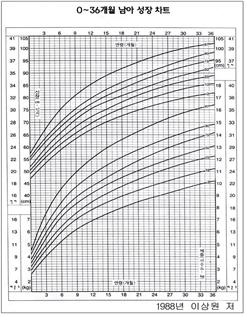
그림 3-57. 생후 0~36개월 된 한국 남 신생아들과 남 영유아들의 성장차트와 체중·신장 백분위수.
Copyright ⓒ 2012 John Sangwon Lee, MD., FAAP
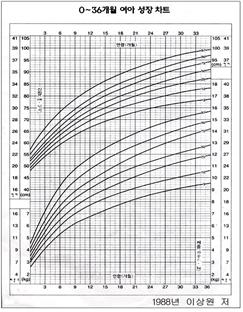
그림 3-58. 생후 0~36개월 된 한국 여 신생아들과 여 영유아들의 성장차트와 체중·신장 백분위수.
Copyright ⓒ 2012 John Sangwon Lee, MD., FAAP

사진 3-59. 생후 6개월경 된 영아가 정기 건강검진을 받는다. 그 때 체중도 잰다.
Copyright ⓒ 2012 John Sangwon Lee, MD., FAAP
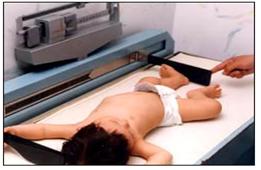
사진 3-60. 생후 6개월경에 정기 건강검진을 받는다. 그리고 그때 신장도 잰다.
Copyright ⓒ 2012 John Sangwon Lee, MD., FAAP
| 생후 6~8개월 영아들의 발육 |
Development of 6~8-month-old infants
1. 생후 6~8개월 영아들의 신체 발육
- 생후 6~7개월 된 대부분의 영아들은 바닥에 앉히면 잠시 동안 혼자 앉을 수 있다.
- 일부는 자신이 잠시 동안 혼자 앉아 있을 수 있다.
- 조금 앉아 있다가 쓰러지기도 한다.
- 도움 없이 자신이 오랫동안 제법 잘 앉아 있을 수 있다.
- 두 팔을 잡고 앉히면 등이 활처럼 앞으로 구부러질 수 있다.
- 이 시기 대부분의 영아들은 앞 쪽에서 뒤쪽으로, 뒤쪽에서 앞쪽으로 엎칠 수 있다.
- 두 팔을 앞으로 내밀고 전신을 움직여서 앞으로 갈 수 있다.
- 양다리를 움직여 앞으로 조금 기어 갈 수 있고 배 전체를 바닥에 대고 길 수 있다.
- 몸통 양쪽을 두 손으로 잡고 꼿꼿이 세우면 혼자서 잠시 동안 설 수 있다.
- 일부의 영아들은 엄마 아빠의 손이나 집안 의자 등 가구를 잡고 잠시 동안 서 있을 수 있다.
- 성장 발육이 좀 더 빠른 영아들의 일부는 의자 등을 잡고 혼자서 제법 잘 설 수 있다.
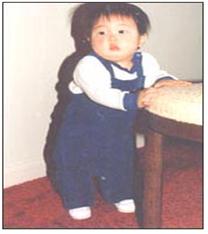
사진 3-61. 6~9개월 된 영아들의 대부분은 의자나 다른 가구를 잡고 혼자 설 수 있다.
Copyright ⓒ 2012 John Sangwon Lee, MD., FAAP

사진 3-62. 8개월 된 영아들의 대부분은 전 복부를 바닥에 대고 혼자서 잘 길 수 있다.
Copyright ⓒ 2012 John Sangwon Lee, MD., FAAP
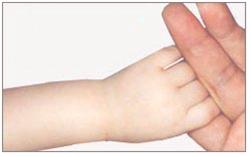
사진 3-63. 아기와 엄마가 신체적 접촉사랑을 서로 하고 있다. 사랑 반딩을 형성하고 있다
Copyright ⓒ 2012 John Sangwon Lee, MD., FAAP
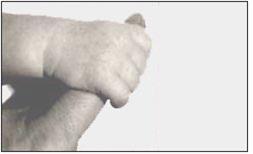
사진 3-64. 아기와 아빠가 서로 신체적 접촉 사랑을 하고 사랑을 하고 사랑 반딩을 형성하고 있다.
Copyright ⓒ 2012 John Sangwon Lee, MD., FAAP
2. 생후 6~8개월 영아들의 손 발육
- 예쁘고 작은 손을 수의적으로 움직일 수 있다.
- 이제 아기 스스로 손을 수의적으로 많이 쓸 수 있다.
- 아기 크립이나 침대에 매달아 놓은 장난감이나 실내 바닥에 있는 장난감을 손으로 잡고 혼자 놀 수 있다.
- 손으로 장난감을 자기의 눈앞에 가까이 가져다 보면서 오랫동안 놀 수 있다.
- 한쪽 손에 쥔 장난감을 다른 쪽 손으로 옮겨 잡을 수 있다.
- 이 나이의 영아들의 일부는 한쪽 손을 다른 쪽 손보다 더 많이 사용한다.
- 과자나 우유병을 손으로 들고 자신이 먹을 수 있다.
- 엄지와 집게손가락을 이용해 작은 물체를 집을 수 있다.

사진 3-65. 장난감을 잡으려고 한다.
Copyright ⓒ 2012 John Sangwon Lee, MD., FAAP

사진 3-66. 양 손에 정육면체 블록을 가지고 놀 수 있다.
Copyright ⓒ 2012 John Sangwon Lee, MD., FAAP
3. 생후 6~8개월 영아들의 언어 발육
- 거울을 들여다보고 거울에 비친 자신의 영상에게 이해할 수 없는 아기 말로 종알거리면서 놀 수 있다.
- 때로는 혼자 크게 소리 내어 웃기도 하고 거울에 비친 자신의 영상을 손으로 만져 보려고도 한다. 엄마 아빠나 다른 사람이 영아에게 말을 걸면 말하는 사람의 눈과 입 등 몸짓을 쳐다보고 말을 배우기 시작한다.
- 남들이 하는 말을 흉내 내기도 하고 이해할 수 없는 아기 말을 반복하기도 한다.
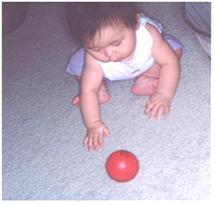
사진 3-67. 발육이 빠른 생후 9개월 된 영아들은 공을 잡으려고 앞으로 기어간다.
Copyright ⓒ 2012 John Sangwon Lee, MD., FAAP
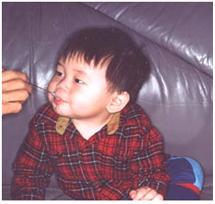
사진 3-68. 이유식을 먹고 싶을 때는 턱을 앞으로 내밀고 먹기 싫으면 고개를 옆쪽으로 돌리든지 또는 뒤쪽으로 젖힌다. 이와 같이 몸짓 말을 잘한다.
Copyright ⓒ 2012 John Sangwon Lee, MD., FAAP
4. 생후 6~8개월 영아들의 사회성 발육
- 이때까지 모든 영아들은 자기의 엄마 아빠에게 거의 모든 면에서 전적으로 의존하면서 자라왔다. 그러나 이제는 엄마 아빠가 도와주지 않더라도 영아 스스로 엎칠 수도 있고, 기어 다닐 수 있다.
- 일부 영아들은 혼자 기고 앉고, 갖고 싶은 장난감을 갖기 위해 한 자리에서 다른 자리로 어느 정도 이동할 수 있다.
- 컵으로 음료수를 자신이 마시고 이유식 아기과자를 자신이 손으로 잡고 먹을 수 있다.
- 자기가 먹고 싶은 이유식을 선택해서 먹고, 먹기 싫은 이유식은 뱉어내기도 한다.
- 이때 그들은 엄마 아빠로부터 완전히 독립한 것같이 생각하는 것 같다.
- 대부분 영아들은 그들의 주위에 있는 모든 것을 갖고 싶어 한다.
- 그런 것들을 다 가질 수는 없지만 적어도 갖고 싶은 것을 가져보려고 무척 애쓰는 것을 볼 수 있다([부모도 반의사가 되어야 한다-소아가정간호백과]-제 18권 소아청소년 이비인후 질환-난청이 있는 아이 참조).
- 이 시기의 영아를 실내에 혼자 두고 엄마 아빠가 실외로 나가면 그도 엄마 아빠를 따라 나오려고 애쓰기도 한다.
- 집에서 형이나 누나와 함께 놀기를 아주 좋아한다.
- 낯선 사람을 보면 전보다 더 많이 낯을 가릴 수 있다.
- 생후 9~10개월까지 영아의 몸통을 잡을 때 서지 못하거나,
- 생후 10~11개월까지 손가락으로 작은 물건을 집을 수 없거나,
- 8~9개월까지 “다다”, “바바” 등 말을 할 수 없던지,
- 피카브를 할 수 없거나,
- 놀 때 크게 소리 내어 웃지 않으면 성장 발육에 어떤 이상이 있나 성장 발육 평가를 꼭 해봐야 한다(“생후 1개월~6세의 영유아들의 자세한 발육 이정표”).
| 생후 6~8개월 영아들의 장난감 |
장남감 참조.
| 생후 6~8개월 영아들의 영양 |
1. 모유수유
- 엄마의 젖을 전보다 더 즐겁게 빨아먹는 것이 보통이다.
- 젖을 먹는 동안 엄마하고 장난을 치기를 전보다 더 좋아한다.
- 젖니가 나 있는 영아들은 엄마의 젖꼭지를 물어도 보고 물고 당겨 보기도 한다.
- 하루 4~6번 정도 모유수유를 할 수 있다.
- 이때의 대부분의 영아들은 밤에 한 번 잠들면 젖도 먹지 않고 아침까지 계속 잘 수 있다.
- 모유만 먹는 아기에게는 철분과 불소가 든 종합비타민제를 매일 먹이는 것이 좋다.
- 모유만 먹는 대부분의 영아들은 인공영양을 먹을 때보다 더 쉽게 배고플 수 있다.
- 이런 경우는 모유수유도 하고 인공영양도 먹일 수 있다.
- 이 때 인공영양은 일종의 이유식으로 간주할 수 있다.
- 모유수유도 하고 이유식을 먹일 수 있다.
- 인공영양을 우유병이나 이유 연습용 영아 컵이나 숟가락으로 먹일 수 있다.
- 갑자기 이유해서는 안 된다.
- 이유를 할 계획을 하면 이유하기 위한 준비를 이때부터 서서히 하기 시작한다([부모도 반의사가 되어야 한다-소아가정간호백과] 제 4권 모유, 모유수유, 이유-젖을 뗄 때 참조).
2. 인공영양
- 이때의 대부분의 영아들은 고형 이유식을 잘 씹어 먹을 수 있을 정도로 젖니가 많이 나 있지 않다.
- 이가 없어도 먹기 좋게 이유식을 집에서 요리해서 먹이든지, 주니어 이유식을 먹이기 시작할 수 있다.
- 그 동안 인공영양을 먹던 영아들에게는 인공영양을 주식으로 계속 먹일 수 있다.
- 영아들이 이유식을 잘 먹고 소화를 잘 시키고 전반적으로 건강하면서 문제가 없으면 인공영양과 이유식을 먹일 수 있다.
- 이때 먹을 수 있는 인공영양의 양은 영아의 크기와 먹성에 따라 다르고 먹고 있는 이유식의 종류와 양에 따라 다르다.
- 인공영양은 1회 분 180~240cc 정도를 하루 4~6번 정도 먹인다.
- 이 시기 영아들은 자신이 우유병을 붙들고 인공영양을 먹을 수 있으나 그들 자신이 우유병을 붙들고 인공영양을 혼자 먹게 내버려두지 말고 엄마 아빠가 아기를 품에 포근히 안고 사랑하면서 먹여야 한다.
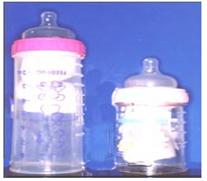
사진 3-69. 특수 우유젖병.
Copyright ⓒ 2012 John Sangwon Lee, MD., FAAP

사진 3-69. 이유식을 먹일 때 쓸 수 있는 연습용 컵.
Copyright ⓒ 2012 John Sangwon Lee, MD., FAAP
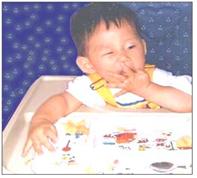
사진 3-70. 이유식을 손으로 먹을 수 있다.
Copyright ⓒ 2012 John Sangwon Lee, MD., FAAP
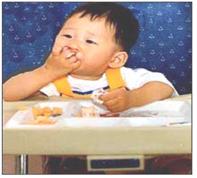
사진 3-71. 이유식을 손으로 먹을 수 있다.
3-6세 유아들을 수저로 먹이는 부모도 있다. 이런 식으로 자녀를 양육하면 독립심을 길러주는데 해가 될 수 있다. Copyright ⓒ 2012 John Sangwon Lee, MD., FAAP
3. 이유식

사진 3-72. 이유식을 영아 스스로 손으로 먹을 수 있다. Copyright ⓒ 2012 John Sangwon Lee, MD., FAAP
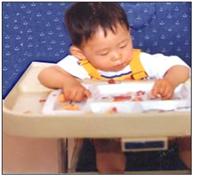
사진 3-73. 이유식을 손으로 먹을 수 있다. Copyright ⓒ 2012 John Sangwon Lee, MD., FAAP
- 이유식을 하루 몇 번 정도 먹일 수 있고 인공영양이나 모유와 이유식을 먹일 때 언제 이유식을 먹여야 가장 좋은지 확실히 일률적으로 정할 수 없다.
- 인공영양이나 모유를 먹인 바로 후나, 전이나, 또는 모유수유나 인공영양을 먹이는 사이사이에 이유식을 먹일 수 있고, 모유나 인공영양을 먹일 시간에 모유나 인공영양을 먹이는 대신 이유식을 먹일 수 있다.
- 곡물류 이유식(시리얼류 이유식), 과일류 이유식이나 채소류 이유식을 하루 3, 4번 정도 먹이는 것이 보통이다.
- 엄마아빠나 가족 성원의 일상생활 리듬 패턴에 걸 맞는 시간을 선택해 이유식을 먹일 수 있다.
- 이유식은 숟가락으로 먹일 수 있고 과일즙류 이유식이나 주스류 이유식은 보통 컵으로나 이유 연습용 컵으로 먹일 수 있다.
- 엄마 아빠의 생각으로는 좋은 이유식이라도 영아에게는 좋은 이유식이 아닐 수 있다.
- 영아의 입맛을 존중해야한다.
- 대개 엄마 아빠에게 맛이 없는 이유식은 영아에게도 맛이 없는 것이다.
- 맛이 있는 이유식을 선택해서 이유식을 아기에게 먹일 수 있고 집에서 이유식을 만들어 먹일 수 있다.
- 이유식에 소금이나 설탕을 첨가할 때 권장 이상 또는 이하로 가해서는 안 된다.
- 첫 돌 때까지 달걀 흰자위를 먹이지 말고 익힌 노른자는 조금 먹일 수 있다.
- 이 나이의 영아들에게 전우유나 생우유를 먹여서는 안 된다.
- 무, 비트, 당근, 시금치 등의 채소류는 첫 돌 이전에 먹이는 것을 권장하지 않는다.
4. 물과 수분
- 맹물, 숭늉, 보리차, 또는 그 외 수분을 가끔 컵으로 먹여도 된다.
- 사이다나 콜라 등 청량 음료수는 먹이지 않는 것이 좋다.
- 무더울 때는 필요에 따라 맹물을 더 자주 먹여도 된다.
5. 비타민제와 철분제 그리고 불소제
- 모유만 먹는 영아들에게 철분과 불소가 든 종합 비타민제를 매일 먹여도 된다.
- 인공영양 속에 철분과 비타민이 충분히 들어 있다.
- 인공영양을 먹는 영아들은 철분제와 비타민제를 따로 더 먹일 필요 없다.
| 생후 6~8개월 영아들의 양호 (Ⅱ) |
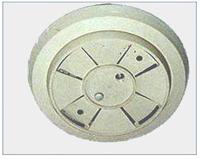
사진 3-74. 화재와 화상을 예방하기 위해 화재경보기를 집안에 설치한다.
Copyright ⓒ 2012 John Sangwon Lee, MD, FAAP
- 생후 6개월 경 정기 건강검진을 해주고, 이전에 다음 백신 3차 접종을 받지 안 했으면, 3차 DTaP, 3차 불활성 소아마비 백신(IPV), 3차 B형 간염 예방접종 백신(HepB), 3차 폐렴 연쇄성 구균에 의한 감염병 예방접종 백신(PCV)과 히브 예방접종 백신(Hib), 로타(RV)백신으로 접종받는다(예방접종표 표 2-11 참조).
- 결핵을 앓고 있는지 알아보기 위해 투베르쿨린 결핵 피부 반응 검사나 PPD 결핵 피부 반응검사를 받는다.
- 생후 6개월경에 정기 건강검진을 받은 영아는 생후 9개월에 다음 정기 건강검진을 받는 것이 보통이다.
- 히브 예방접종백신은 그 종류에 따라 생후 6개월에 3차 히브 예방접종을 할 수 있고 생후 15개월에 할 수 있다.
- DTaP 백신 예방접종만 접존 받을 수도 있고, DTaP와 히브 예방접종약이 든 테트라뮨 예방접종약으로 디피티 백신과 히브 예방접종백신을 주사 한대로 예방접종을 받을 수도 있다. 종합 ProQuad 백신이나 Pediarix 백신으로 예방 접종을 할 수 있다.
- “Menhibrix 백신(2012년 6월)-미 FDA Neisseria meningitidis 혈청형 C, Y와 Haemophilus influenzae type b (Hib) 로 생기는 패혈증과 뇌수막염을 예방 할 수 있는 종합 백신이다. 생후 2, 4, 6개월과 12 ~15 개월에 총 4화 접종받을 수 있고 최초 접종은 생후 6주에 접종 받을 수 있다. 출처 Physician’s First Watch for June 15, 2012
| 생후 6~8개월 영아들의 질병 안전사고 예방 |
- 이 시기의 대부분의 영아들은 그들의 손에 닿을 수 있는 것은 엎지르고, 닥치는 대로 밀고, 잡아당기고, 만지고 부수고 놀 수 있다.
- 높은 곳에서 떨어져 낙상 사고가 생기지 않게 주의하고
- 독극물 중독사고, 약물 중독사고, 화학물질 중독, 질식사고, 화상사고 등의 안전사고가 생기지 않게 예방해야 한다.
- 집안에 이페칵 시럽이나 활성 탄말을 의사의 처방에 따라 보관했다가 의사의 지시에 따라 필요할 때 쓸 수 있다.
- 특히 의료 시설에서 멀리 떨어져 사는 소아청소년을 위해 이런 독극물 응급치료약을 집안에 의사의 처방에 따라 보관하는 것도 좋은 것이다.
- 승용차를 타고 영아 자녀를 데리고 어디를 갈 때 법에 따라 만든 안전의자에 앉히고 운전한다.
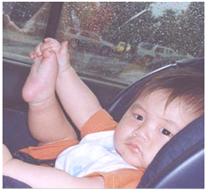
사진 3-75. 승용차를 탈 때 영유아용 안전의자에 앉힌다.
Copyright ⓒ 2012 John Sangwon Lee, MD., FAAP
|
다음은 “잠들기가 너무 힘들어요”에 관한 인터넷 소아청소년 건강상담 질의응답의 예입니다. |
Q&A. 잠들기가 너무 힘들어요.
Q.
- 6개월 째 접어든 몸무게 8Kg의 여아입니다. 태어나 4일후에 패혈증으로 2주간 입원한 적이 있습니다. 저의 아긴 잠들기가 너무 힘들어요.
- 한참 혼자서 칭얼거리며 이불당기며 입으로 빨다가 눈물까지 흘리며 울다가를 20분가량 하다가 잠이 들곤 합니다. 여기서 잠버릇에 관한 글을 읽고 혼자 재우려고 내버려두기도 했습니다.
- 간혹 그러다 잠들기도 했지만 너무 힘들어하는 것 같기도 해서 요람을 태워 흔들거나 제가 업어 재우기도 합니다. 요람을 태우거나 업어도 칭얼대다 잠이 듭니다. 아기가 몸이 좋지 않아서인가하는 생각도 듭니다. 제가 어떻게 해야 하나요.
- 그리고 한 가지 더 태어날 때부터 푸른 변을 지속적으로 봐왔습니다. 병원에 갔더니 괜찮다고 하더군요. 곧 황색으로 변하겠거니 했지만 지금까지도 매일 푸른 변만 봅니다.
- 낮엔 잘 웃고 잘 먹구요, 특별히 놀란 적은 없습니다. 병원에 가봐야 할까요??
- 답변 부탁드립니다.
A.
- 신선님 안녕하세요.
- 질문해 주셔서 감사합니다. 좋은 질문입니다.
- 자녀의 나이, 성별, 과거 병력, 가족 병력, 진찰소견, 임상검사 등의 정보를 많이 알수록 답을 드리는데 도움이 됩니다. 주신 정보를 토대로 해서 답변을 드리겠습니다.
- 소아청소년과에서 소아청소년(0-18세)를 진료하다보면 자녀들의 잠자는 문제, 먹는 문제, 대소변 가리는 문제에 관한 질문을 자주 받습니다.
- 이 세상에 완전한 사람도 없고 완전한 부모도 없고 완전한 소아청소년도 없습니다.
- 모든 부모들은 자녀를 사랑해서 잘 키워보려고 노력 하는 것이 부모들의 본능입니다.
- 어떤 아기는 너무 잠만 자서 왜 이렇게 잠만 자나 하고 부모가 살그머니 잠자는 아기를 들여다보기도 하고 곤히 잠자는 아기 자녀를 깨서 먹이기도 합니다.
- 그러나 어떤 아기들은 그와 반대로 자궁에서도 더 많이 차고 놀기도 합니다.
- 태어나자마자 두 눈을 뜨고 두리번거리면서 세상을 살펴(?)보는 아기들도 있습니다.
- 잠을 다른 아기들보다도 덜 자지만 아주 건강하게 크는 아기들도 있습니다.
- 기르기가 어려운 아기들도 있고 기르기가 쉬운 아기들도 있습니다.
- 이렇게 각 아기마다 제각기 다른 천성을 가지고 태어납니다.
- 그 천성을 바로 바로 고친다는 것은 대단히 어렵습니다.
- 그래서 천성은 난개란 말이 생긴 것 같습니다. [부모도 반의사가 되어야 한다–소아가정간호
- 백과]-제 22권 아들 딸 이렇게 키우시오–타고난 9가지 기질 참조.
- 제가 보기로서는 아기의 잠자는 습관이 비정상적은 아닌 것 같습니다.
- 그러나 아기가 하는 일이 잘못됐으면 그것을 바로잡는 훈련을 시키는 것은 부모가 할 일이며 또한 부모의 책임이기도 합니다.
- 그럼 이렇게 해 보시지요.
① 평소에 눈길 접촉 사랑과 신체적 접촉 사랑을 조건 없이 진심으로 많이많이 해주십시오. 부모도 반의사가 되어야 한다–소아가정간호 백과–제 22권 아들 딸 이렇게 키워라–사랑 참조
② 어디가 아픈지, 배가 고픈지, 잠자리가 편안한지, 아기는 부모와 다른 침실을 따로 쓰는지, 춥거나 더운지, 부부가 화목한지 침실 환경이 잠자기에 적절한지 살펴보시고 필요에 따라 고쳐보십시오.
③ [부모도 반의사가 되어야 한다–소아가정간호백과]-제 22권 아들 딸 이렇게 키우시오–잠자는 훈련을 읽어보시고 동의하시면 그 잠자는 훈련에 있는 권장대로 실행해 보십시오. 그에 관해 질문이 있으시면 저에게 구체적으로 질문해 주십시오.
④ 이렇게 해도 저렇게 해도 제대로 잠을 재울 수 없는 아기도 있습니다. 그리고 기관지 천식 등 어떤 병이 있어도 잠을 잘 못 잘 수 있습니다. 의사와 상담해서 알아보셔요.
- 저는 한 번도 약을 먹여 아기를 재우라고 한 적이 없습니다.
- 해결할 수 있는 열쇠는 시간입니다. 그리고 사랑입니다
- 대변을 그렇게 오랫동안 푸르게 보는 것은 비정상적이나 잘 성장하고 별 이상이 없으면 자연히 없어지리라고 믿습니다.
- 뉴트라미젠 특수 인공영양을 먹을 때 대변색이 푸르고 설사 변을 봅니다.
- 혹시 그런 종류의 인공영양을 먹어 생기는 대변인지 의심이 갑니다.
- 그것에 대해 단골 의사선생님께 문의하시기 바랍니다.
- 해당 연령 성장 발육, p.00 생후 1개월~6세 아이들의 발육 이정표. [부모도 반의사가 되어야 한다–소아가정간호백과]-제 22권 아들 딸 이렇게 키우시오–생후 5~29개월 영유아들의 수면 등을 참조하시기 바랍니다.
- 질문이 더 있으면 다시 연락해 주시기 바랍니다. 감사합니다. 이상원 드림
|
다음은 “6개월 영아의 이유식”에 관한 인터넷 소아청소년 건강상담 질의응답의 예 입니다. |
Q&A. 6개월 영아의 이유식.
Q.
- 오랜만에 질문 드립니다.
- 선생님 늦었지만 새해 복 많이 받으세요. 갑상선 기능 저하증세가 있는 엄마인데요
- 전에 아기가 체중이 잘 늘지 않아 다시 검사한 결과 괜찮게 나왔었습니다.(2002년 11월중순)
- 8월22일생인 3.05에 출생한 여아입니다. 지금 몸무게가 6.2밖에 안 됩니다.
- 3주 전부터 갑자기 아기가 분유량이 줄었어요. 평소에 양이 적은 아이라 분유량에 굉장히 예민해져 있는 상태거든요. *3주전 수유량(3시간마다 100~140ml:평균적으로 120ml) →3주전 하루 총 수유량 730±30(1월24일까지) 문제는 그 이후부턴데요 25일부터 차츰 650에서 30일부터 3단계 분유로 들어갔는데 500ml도 겨우 먹더라구요. 구정이라 시골집에서 환경이 바뀐 탓도 있지만 3~4시간에 70~100ml밖에 먹질 않더라구요. 많이 먹어야 100ml.
- 현재 이유식은 쌀미음으로 평균 아기스푼으로 10스푼주고 있구요. 4번 시판 가루 이유식 먹인 적 있습니다. 1주일 전까지 사과즙 2~3스푼씩8일 준 적 있구요. 분유 3단계로 넘어오기 바로 전, 후 지금까지 많이 먹어야 4시간에 100~120밖에 먹질 않습니다.
- 아침 일어나서는 50~70밖에 먹질 안구요.
- 그래서 3일 전부터 분유를 다른 회사 걸로 1스푼씩 섞어 먹이고 있는데 큰 차도는 보이질 않고 있습니다. (1달반 전에 분유를 한 번 바꾼 적이 있습니다. (2단계부터) 먹기는 먹었는데 먹고 나서 1~2시간이 지나도 꺼억 꺼억 합니다) 이 기간에 감기 증세는 보이질 않았구요, 가끔식 재채기와 잔기침 하는 정도였는데 소아청소년과에서 장 활동약 처방받아 2틀 먹였습니다.
- 분유 때문인지 아기의 일시적인 현상인지 거의 3주가량이 다되어가는데 원상복귀가 안 되고 있거든요. 잘 놀고 잘 자는 것 같긴 한데 좀 쉽게 지치는 것 같기도 하구요 조금 보챕니다.
- 아이가 스푼으로는 잘 먹어서 낮에 선 이유식 후 분유를 주다가 선 분유, 후 이유식으로 바꾸고도 이유식은 전에 먹던 데로 잘 받아먹고 중간 분유 수유 시에도 가끔식 젖병으로 주고 스푼으로 나머지 양을 조금 먹일 때가 있는데 이렇게 하면 아이가 체하지는 않는지.
- 2일 전에 애호박, 단호박을 미음에 섞어 먹이고 변경분유도 1스푼씩 먹였는데 이마에 빨갛게 좁쌀처럼 뭐가 났는데 이유식 때 확인을 못 한터라 원인이 뭔지 모르겠습니다. 그래서 오늘은 미음만 줬는데. 분유 알러지인지 이유식 알러지인지. 1월28일 날 6.0kg였는데 3일 전에 병원에 갔었는데 내복 입고 6.2kg더라구요.
- 체중이 왜 이렇게 늘지 않는 것일까요. 너무 속상합니다.
- 제가 앞으로 어떻게 해야 할지 잘 모르겠습니다.
- 선생님의 답변 기다리겠습니다.
A.
- 수선님 안녕하세요.
- 질문해 주셔서 감사합니다.
- 좋은 질문입니다.
- 그 동안 아기가 많이 자란 것을 축하드립니다.
- 갑상선 문제는 해결됐으니 더 이상 걱정하실 필요는 없는 것 같습니다.
- 생후 6~9개월 정도 된 영아들은 어떻게 보면 독립 추구를 강렬하게 합니다.
- 이런 면에서는 사춘기 아이들과 비슷한 점이 다소 있습니다.
- 자기들이 먹고 싶을 때 먹을 것을 주면 턱을 앞으로 내밀고 입을 벌리고 주는 음식물을 잘 받아먹습니다.(사진 3-77 참조)
- 만일 먹고 싶지 않으면 고개를 옆으로 돌리든지 뒤로 젖히든지 때로는 손으로 수저를 밀어냅니다.
- 그래서 이전 같이 엄마아빠가 마음대로 먹일 수 없는 때가 많이 있습니다.
- 점잖은(?) 영아들은 주는 음식물을 입을 벌리고 잘 받아 입 안에 넣은 후 삼키지 않고 뱉어내든지 구역질해서 그 음식물을 넘기지 않고 섭취하지도 않습니다.
- 저에게 맛이 좋지 않으면 한 번 받아먹은 후 아예 입을 벌리지도 않습니다.
- 음식물 그릇을 엎어 버리는 점잖지 않은(?) 영아들도 있습니다.
- 이렇게 자기들이 먹고 싶은 대로 하고 싶은 대로 먹습니다.
- 인제 그들은 업치기도하고 어떤 영아들은 앉기도 합니다.
- 이 시기 영아들은 강력히 독립을 추구합니다.
- 이런 독립 추구력이 영아에게 있는 것은 극히 다행스러운 현상입니다.
- 이런 것이 없다면 자녀를 소중히 여기고 사랑하는 부모들은 영아들에게 너무 많이 먹여 영아들이 과체중아가 되든지 비만아가 될 수 있습니다.
- 이 나이에 하루 4~5번 정도 이유식을 먹이기 전 인공영양(조제분유)을 먹입니다.
- 이유식을 적절하게 먹여야 합니다.
- 이 나이 영아에게 채소류 이유식이나 과일류 이유식을 많이 먹이는 것은 권장하지 않습니다.
- 하루 중 필요로 하는 수분, 칼로리, 단백질, 지방, 탄수화물, 비타민, 미네랄 등이 든 균형 잡힌 음식물을 먹여야 합니다.
- 똑같은 음식물을 동량으로 일률적으로 모든 영아들에게 먹일 수는 없습니다.
- 수선님께서 자녀 사랑하시는 마음이 뚜렷합니다. 쉽게 생각하시고 이유를 하셔요.
- [부모도 반의사가 되어야 한다–소아가정간호백과]-제 22권 아들 딸 이렇게 사랑해 키우세요–이유식, 제 4권 모유, 모유수유, 이유를 참조하시고 소아청소년과에서 이유식에 관한 조언을 얻으십시오.
- 소아청소년과에서 진찰 검진을 받으시고 아기의 체중과 신장이 성장차트의 체중 백분위선과 신장 백분위선에 따라 잘 자라고 있나 확인해 보시고 어떤 이상이 있으면 이 문제에 관해서 상담하시기 바랍니다.
- 일반적으로 생후 6개월 정도 되면서 영아들의 먹는 양이 충분치 않은 것같이 먹습니다.
- 성장속도가 정상적으로 전보다 느려지고 잠도 덜 자는 것이 정상입니다.
- 해당 연령 성장 발육, 생후 1개월~6세 아이들의 발육 이정표. 제 5권 인공영양, 우유, 이유, 비타민, 미네랄, 단백질, 탄수화물, 지방, [부모도 반의사가 되어야 한다–소아가정간호백과]-제 22권 아들 딸 이렇게 사랑해 키우세요–이유식 등을 참조하시기 바랍니다.
- 질문이 더 있으시면 다시 연락 주시기 바랍니다. 감사합니다. 이상원 드림
Growth and development of 6-8-month-old infants
Growth of 6-8-month-old infants
Table 3-4. Percentiles of weight and height of 6-month-old Korean infants percentile
|
Percentile
Gender |
3 | 10 | 25 | 50 | 75 | 90 | 97 | |
| boy | weight (kg) | 6.30 | 6.90 | 7.50 | 8.00 | 8.68 | 9.35 | 10.05 |
| height(cm) | 62.0 | 64.0 | 66.0 | 68.0 | 69.6 | 72.0 | 76.2 | |
| girl | weight (kg) | 5.90 | 6.40 | 7.00 | 7.50 | 8.00 | 8.60 | 9.70 |
| height(cm) | 61.0 | 62.8 | 64.5 | 66.2 | 68.0 | 70.0 | 75.0 |
Table 3-5. Percentiles of weight and height of 7-month-old Korean infants
|
Percentile
Gender |
3 | 10 | 25 | 50 | 75 | 90 | 97 | |
| boy | weight (kg) | 6.60 | 7.10 | 7.60 | 8.20 | 8.90 | 9.60 | 10.50 |
| height(cm) | 63.4 | 65.0 | 67.0 | 68.8 | 71.0 | 73.0 | 97.3 | |
| girl | weight (kg) | 6.17 | 6.17 | 7.20 | 7.80 | 8.50 | 9.10 | 10.40 |
| height(cm) | 62.0 | 62.0 | 66.0 | 67.6 | 69.6 | 72.0 | 77.3 |
• Around 6 months of age, children receive regular health check-ups and measure their weight and height.
• Draw the measured weight and height values on the growth chart weight and height percentiles.
• Find out where his weight and height are on the weight and height percentiles of the growth chart.
• Weight and height follow the growth chart weight and height percentiles
• Continue to grow at the same rate and see if you are growing normally.
• It is normal to gain an average of 15g per day from the age of six months to the age of stone.
• The rate of weight gain from 6 months to 1st birthday is normally slower than the rate of weight gain during the first 6 months of life.
• For one reason or another, most infants from 6 months to their first birthday seem to eat less than they ate during the first 6 months of life.

Figure 3-57. Growth charts and weight and height percentiles for Korean male newborns and male infants aged 0 to 36 months of age. Copyright ⓒ 2012 John Sangwon Lee, MD., FAAP

Figure 3-58. Growth charts and weight and height percentiles for Korean newborn girls and infants aged 0 to 36 months. Copyright ⓒ 2012 John Sangwon Lee, MD., FAAP

Picture 3-59. Infants aged around 6 months receive regular health check-ups. At that time, the weight is also measured. Copyright ⓒ 2012 John Sangwon Lee, MD., FAAP

Picture 3-60. Get regular health checkups around 6 months of age. And then measure your height. Copyright ⓒ 2012 John Sangwon Lee, MD., FAAP
Development of 6-8-month-old infants
1. Physical development of 6-8-month-old infants
• Most infants 6 to 7 months of age can sit alone for a while if they are placed on the floor.
• Some may find themselves sitting alone for a while.
• They may fall down after sitting for a while.
• Can sit fairly well for long periods of time without assistance.
• If you hold their arms and sit down, their back can bend forward like a bow.
• Most infants at this age can lean from front to back and back to front.
• You can move forward by putting his arms out in front of you and moving his whole body.
• They can crawl forward a little by moving their legs, and they can keep their entire belly on the floor.
• Hold both sides of the body with both hands and stand upright for a while.
• Some infants may be able to stand for a while holding their mother’s and father’s hands or furniture, such as a chair in the house.
• Some of the faster-growing infants are able to stand fairly well on their own, holding the back of a chair.

Picture 3-61. Most infants 6 to 9 months old can stand alone while holding a chair or other furniture. Copyright ⓒ 2012 John Sangwon Lee, MD., FAAP

Picture 3-62. Most 8-month-old infants can sleep on their own with their entire abdomen on the floor. Copyright ⓒ 2012 John Sangwon Lee, MD., FAAP

Picture 3-63. Baby and mother making physical contact love. forming a love bonding Copyright ⓒ 2012 John Sangwon Lee, MD., FAAP

Picture 3-64. A baby and her dad make love and make physical contact with each other and form a love bonding. Copyright ⓒ 2012 John Sangwon Lee, MD., FAAP
2. Hand development of 6-8-month-old infants
• Able to voluntarily move pretty little hands.
• The baby can now use her hands voluntarily a lot on her own.
• Able to play alone while holding baby creeps, toys hanging from the bed, or toys on the floor indoors.
• Can play for a long time while holding the toy in her hand close to her eyes.
• Able to move a toy in one hand to the other.
• Some infants at this age use one hand more than the other.
• Able to eat cookies or milk bottles by hand.
• Can pick up small objects with thumb and forefinger.

Picture 3-65. Trying to grab a toy. Copyright ⓒ 2012 John Sangwon Lee, MD., FAAP

Picture 3-66. He can play with cube blocks in both hands. Copyright ⓒ 2012 John Sangwon Lee, MD., FAAP
3. Language development of 6-8-month-old infants
• He can look into a mirror and play with his own image in the mirror, chirping in incomprehensible baby words.
• Sometimes he laughs out loud to himself, and sometimes he tries to touch the image of himself in the mirror with my hand. When a mother, father, or other person speaks to an infant, they begin to learn to speak by looking at the speaker’s eyes, mouth, and other gestures.
• Mimics what other people say and repeats baby words that they don’t understand.

Picture 3-67. Rapidly developing 9-month-old infants crawl forward to catch the ball. Copyright ⓒ 2012 John Sangwon Lee, MD., FAAP

Picture 3-68. If he wants to eat baby food, stick his chin forward, and if he doesn’t want to eat, turn his head to the side or tilt it back. He is good at gesturing like this. Copyright ⓒ 2012 John Sangwon Lee, MD., FAAP
4. Social development of 6-8-month-old infants
• Up to this time, all infants have grown up completely dependent on their mothers and fathers in almost every way. But now, even if mom and dad don’t help, infants can roll over and crawl on their own.
• Some infants crawl and sit alone, and can move somewhat from one seat to another to get the toy they want.
• You can drink beverages from a cup and eat baby food with your own hands.
• They choose and eat the baby food they want to eat, and spit out the baby food they don’t want to eat.
• At this time, they seem to think they are completely independent of their mother and father.
• Most infants want to have everything around them.
• they can’t have all of those things, but they can see them trying very hard to at least have what they want. ).
• If you leave an infant at this age alone indoors and her mom or dad goes outside, she will try to follow her mom and dad out too.
• She likes to play with her brother or sister at home.
• Seeing strangers can make her shyer than before.
• Failing to stand when holding infants by the age of 9 to 10 months;
• Unable to pick up small objects with fingers by 10 to 11 months of age;
• He couldn’t say “Dada” or “Baba” until 8~9 months,
• unable to peekaboo;
• If he does not laugh out loud while playing, you must do a growth and development evaluation to see if there are any abnormalities in growth (“Detailed developmental milestones for infants 1 month to 6 years old”).
Toys for babies 6-8 months old
see toys.
Nutrition for infants 6-8 months old
1. Breastfeeding
• It is normal to suck the mother’s milk more happily than before.
• Prefers to play pranks with mom while breastfeeding.
• Infants with teething may see, bite, and pull on their mother’s nipples.
• You can breastfeed 4 to 6 times a day.
• Most infants at this time can sleep through the morning without breastfeeding once they fall asleep at night.
• For babies who are only breastfed, it is recommended to take a daily multivitamin containing iron and fluoride.
• Most infants who are breastfed alone can become hungry more easily than when fed artificial nutrition.
• In this case, breastfeeding and artificial nutrition can be given.
• In this case, artificial nutrition can be regarded as a kind of baby food.
• You can also breastfeed and feed baby food.
• Artificial nutrition can be fed from a bottle or weaning cup or spoon.
• Do not wean suddenly.
• If you plan to wean, start preparing for weaning gradually from this point (see www.drleepediatrics.com Volume 4 Breastfeeding, Breastfeeding, Weaning – Weaning)
2. Artificial nutrition
• Most infants at this time do not have enough teeth to chew solid baby food well.
• They can cook and feed baby food that is easy to eat without teeth at home, or you can start feeding junior baby food.
• Infants who have been fed artificial nutrition can continue to be fed artificial nutrition as a staple food.
• Infants can be fed artificial nutrition and baby food as long as they eat well, digest well, and are generally healthy, and have no problems.
• The amount of artificial nutrition that can be eaten at this time varies depending on the size and feeding characteristics of the infant and the type and amount of baby food being eaten.
• For artificial nutrition, feed 180~240cc per minute 4~6 times a day.
• At this age, infants can eat artificial nutrition while holding the milk bottle themselves, but do not let them hold the milk bottle and eat artificial nutrition by themselves. Mother and father should hold the baby in their arms and feed it with love.

Picture 3-69. Special milk bottle. Copyright ⓒ 2012 John Sangwon Lee, MD., FAAP

Picture 3-69. A practice cup that can be used when feeding baby food. Copyright ⓒ 2012 John Sangwon Lee, MD., FAAP

Picture 3-70. He can eat baby food with your hands. Copyright ⓒ 2012 John Sangwon Lee, MD., FAAP

Picture 3-71. He can eat baby food with your hands. Some parents feed their 3- to 6-year-old children with spoons. Raising children in this way can be detrimental to developing independence. Copyright ⓒ 2012 John Sangwon Lee, MD., FAAP
3. Baby food

Picture 3-72. Infants can eat baby food with their own hands. Copyright ⓒ 2012 John Sangwon Lee, MD., FAAP

Picture 3-73. Infants can eat baby food with your hands. Copyright ⓒ 2012 John Sangwon Lee, MD., FAAP
• You can feed baby food several times a day, and when feeding artificial nutrition or breast milk and baby food, it is not possible to determine with certainty when it is best to feed baby food.
• You can feed baby food right after, before, or between breastfeeding or artificial nutrition, and you can feed baby food instead of breast milk or artificial nutrition at the time when artificial nutrition or artificial nutrition is given.
• It is normal to feed grain baby food (cereal food), fruit food, or vegetable food 3 or 4 times a day.
• You can feed baby food at a time suitable for the daily life rhythm pattern of Mom, Dad, or family members.
• Baby food can be fed with a spoon, and fruit juice-based baby food or juice-based baby food can be fed with a regular cup or a cup for weaning practice.
• In the opinion of mothers and fathers, good baby food may not be good for infants.
• Respect the taste of infants.
• In general, baby food that does not taste good for mom and dad is also bad for infants.
• You can choose tasty baby food and feed it to your baby, or you can make and feed baby food at home.
• When adding salt or sugar to baby food, do not add more or less than recommended.
• Do not feed the egg whites until the first birth day, and you can feed a small amount of cooked yolks.
• Whole milk or raw milk should not be given to infants of this age.
• It is not recommended to feed vegetables such as radishes, beets, carrots, and spinach before the first birth.
4. Water and Moisture
• They can drink fresh water, barley tea, or other water from time to time in a cup.
• It is not recommended to drink soft drinks such as cider or cola.
• In hot weather, they can drink fresh water more often as needed.
5. Vitamins, iron, and fluoride
• Breastfed infants may be given a daily multivitamin containing iron and fluoride.
• Artificial nutrition contains enough iron and vitamins.
• Infants on artificial nutrition do not need to be supplemented with iron and vitamin supplements.
Good care for 6-8-month-old infants (Ⅱ)

Picture 3-74. Install fire alarms in your home to prevent fires and burns. Copyright ⓒ 2012 John Sangwon Lee, MD, FAAP
• If a regular health checkup is given around 6 months of age and the third dose of the following vaccine has not been received before, 3rd DTaP, 3rd inactive polio vaccine (IPV), 3rd hepatitis B vaccination (HepB), 3rd dose Infectious diseases caused by Streptococcus pneumoniae (PCV), HIV vaccine (Hib), and rotavirus (RV) vaccine are inoculated (refer to Table 2-11 of the Vaccination Table ).
• Get a tuberculin tuberculosis skin test or PPD tuberculosis skin test to see if you have tuberculosis.
• Infants who received regular health check-ups around 6 months of age usually receive the next regular check-up at 9 months of age.
• Depending on the type of HIV vaccine, a third dose of HIV vaccine can be given at 6 months of age or at 15 months of age.
• You can receive only the DTaP vaccine, or you can get vaccinated with the DTaP and tetramine vaccine containing the HIV vaccine as a single injection of the DPT vaccine and the HIV vaccine. Vaccination can be achieved with the combined ProQuad vaccine or Pediarix vaccine.
• “Menhibrix Vaccine (June 2012) – A combined vaccine that can prevent sepsis and meningitis caused by Neisseria meningitidis serotypes C and Y and Haemophilus influenzae type b (Hib) by the US FDA.
A total of 4 doses can be given at 12-15 months of age, and the first dose can be given at 6 weeks of age Source Physician’s First Watch for June 15, 2012
Prevention of diseases and accidents in infants aged 6-8 months
• Most infants at this age can spill, push, pull, touch, crush, and play anything they can reach.
• Be careful not to fall from a high place.
• Safety accidents such as poisoning, drug poisoning, chemical poisoning, suffocation, and burns should be prevented from occurring.
• You can keep Ipecac syrup or activated charcoal at home according to your doctor’s prescription and use it when you need it.
• It is also a good idea to keep these poison first aid kits at home as prescribed by a doctor, especially for children and young people who live far from medical facilities.
• When traveling with your child in a car, sit in a safety seat made in accordance with the law and drive.

Picture 3-75. When riding in a car, sit in a safety chair for infants and children. Copyright ⓒ 2012 John Sangwon Lee, MD., FAAP
The following is an example of a Q&A for children and adolescents on the Internet about “I have a hard time falling asleep”. Q&A. It’s so hard to fall asleep.
Q.
• She is 6 months old and weighs 8 kg. I was hospitalized for 2 weeks with sepsis 4 days after I was born. My baby has a very hard time sleeping.
• For a long time alone, I whimper, pull the blanket, suck with my mouth, shed tears and cry for about 20 minutes before falling asleep. I read an article about sleeping habits here and left it alone to sleep.
• Occasionally, I fell asleep, but it seemed to be too hard, so I rocked the cradle or put myself to sleep. Even if I put the cradle on or carry it, I cry and fall asleep. I wonder if the baby is not feeling well. What should I do?
• And one more thing, I’ve had blue stools consistently since birth. I went to the hospital and he said he was fine. I thought it would turn yellow soon, but so far, I only see blue stools every day.
• I laugh and eat well during the day, and I’ve never been particularly surprised. Should I go to the hospital??
• please answer my question.
A.
• Hello, Mr. Shin.
• Thank you for your question. That’s a good question.
• The more information you have, such as your child’s age, gender, past medical history, family history, examination findings, and clinical tests, the more helpful it is to give you an answer. We will give you an answer based on the information you provided.
• When you work with children (0-18 years old) in the Department of Pediatrics, you are often asked questions about your children’s sleeping problems, eating problems, and problems with toileting.
• There are no perfect people, no perfect parents, and no perfect children and adolescents in this world.
• It is the instinct of all parents to love their children and try to raise them well.
• Some babies sleep too much, so why do they sleep like this? Parents sneak a look at their sleeping babies, or wake up and feed their sleepy babies.
• However, some babies, on the other hand, kick and play more in the womb. • There are babies who look around (?) with their eyes open as soon as they are born.
• Some babies sleep less than other babies but grow very healthy.
• Some babies are difficult to raise and some are easy to raise.
• In this way, each baby is born with a different nature.
• It is very difficult to correct that nature right away.
• So, it seems that the word “difficult to be changed in nature” originated. [Parents must also become anti-doctors – Pediatric and Family Nursing
Encyclopedia]-See Book 22, Raising Sons and Daughters Like This-Nine Temperaments of Nature.
• It seems to me that your baby’s sleeping habits are not abnormal.
• However, it is the parent’s job and also the parent’s responsibility to train the baby to correct if something goes wrong.
• Then try this.
① On a regular basis, please do a lot of love with eye contact and physical contact without any conditions. Parents should also become at least the half-doctors – Encyclopedia of Pediatric and Family Nursing – Volume 22 Raising Sons and Daughters Like This – See Love
② Check if there is any pain if you are hungry if the bed is comfortable if the baby is in a separate bedroom from the parent if it is cold or hot, if the couple is harmonious, and if the bedroom environment is suitable for sleeping, and adjust as necessary.
③ www.drleepediatrics.com – Volume 22 Raising Sons and Daughters Like This – Read the sleeping training and if you agree, follow the recommendations in the sleeping training. If you have any questions about that, please ask me specifically.
④ Even if you do this or that, some babies will not be able to sleep properly. And any illness, such as bronchial asthma, can make it difficult to sleep. Talk to your doctor and find out.
• I’ve never been given medication to put my baby to sleep.
• The key to solving this is time. and it’s love
• I believe that having blue stools for so long is abnormal, but it grows well and will go away on its own if there are no abnormalities. • When you take Nutramigen special artificial nutrition, your stool is blue and you have diarrhea.
• I wonder if it’s a spokesperson for eating that kind of artificial nutrition.
• Ask your regular doctor about it.
• Appropriate age growth and development, Developmental milestones for children aged 1 month to 6 years. [Parents should also become at least the half-doctors – Encyclopedia of Pediatric and Family Nursing] – Volume 22 Raising Sons and Daughters Like This – Please refer to the sleep of infants 5 to 29 months old, etc.
• If you have more questions, please contact us again. Thank you. Lee Sang-won;.
The following is an example of an Internet pediatric health consultation Q&A regarding “weaning food for 6-month-old infants”.
Q&A.
Weaning food for 6-month-old infants.
Q.
• I have a question for you after a long time.
• Sir, I’m late, but Happy New Year. She’s a mom with three hypothyroidism
• Previously, the baby was not gaining weight, so the test again came out okay. (Mid-November 2002)
• A girl born on August 22nd, 3.05. She now weighs only 6.2.
• About 3 weeks ago, my baby suddenly lost formula. She is usually a small child, so she is very sensitive to her formula. *Feeding amount 3 weeks ago (100~140ml every 3 hours: 120ml on average) → Total daily feeding amount 730±30 3 weeks ago (until January 24th) The problem is thereafter. I went in and only ate 500ml. It’s Chinese New Year, so it’s partly because of the change in the environment in the country house, but I only ate 70-100ml every 3-4 hours. 100ml if you eat a lot. • Currently, baby food is rice bran, which is an average of 10 baby spoons. I have fed 4 commercially available powdered baby food. Until a week ago, I was given 2-3 tablespoons of apple juice for 8 days. Just before and after moving on to step 3, if you eat a lot until now, you only eat 100-120 in 4 hours.
• When I wake up in the morning, I only eat 50-70.
• So, 3 days ago, I have been mixing 1 tablespoon of powdered milk with another company’s milk, and there is no significant improvement. (I changed the formula once a month and a half ago. (From step 2) I ate it, but even after 1 to 2 hours of eating, I have no symptoms of a cold. During this period, there were no symptoms of a cold. I have prescribed an intestinal stimulant from the Youth Department and fed it for 2 days.
• Whether it’s because of formula milk or it’s a temporary phenomenon in the baby, it’s been almost 3 weeks and it’s not going back to normal. She seems to be having a good time and sleeping well, but she also seems to get tired easily and is a little carefree.
• The child eats well with a spoon and gives formula after standing baby food during the day, and even after changing to standing formula and after baby food, she eats as usual as she used to eat. If you do this, the child will not pretend.
• Two days ago, I mixed zucchini and sweet pumpkin with rice and fed 1 tablespoon of powdered milk, but something red like millet appeared on my forehead, but I couldn’t confirm it during baby food, so I don’t know what the cause is. So today, I only gave you a Mieum. Are you allergic to formula or baby food? I weighed 6.0kg on January 28th, but I went to the hospital 3 days ago and it was 6.2kg in underwear.
• Why am I not gaining so much weight? I’m so upset.
• I am not sure what to do next.
• We will wait for your reply.
A.
• Hello Susun.
• Thank you for your question.
• Good question.
• Congratulations on your baby’s growth in the meantime.
• Now that your thyroid problem has been resolved, I don’t think you need to worry anymore.
• Infants around the age of 6 to 9 months intensify their pursuit of independence in some ways.
• There are some similarities with adolescents in this respect.
• When they want to eat, when they give them something to eat, they stick their chin forward and open their mouths to accept the food they give. (See picture 3-77)
• If you do not want to eat, turn your head to the side or back, sometimes pushing the spoon with your hand.
• So, there are many times when Mom and Dad can’t feed freely like before.
• Decent (?) infants take food with their mouths open, put it in their mouth, and then spit it out without swallowing it, or nauseous so they don’t pass it up and don’t eat it.
• If it doesn’t taste good to me, I don’t even open my mouth after taking one bite.
• Some infants are not polite (?) who tip their food bowls over.
• In this way, they eat what they want and what they want to eat.
• Now, they are up and some infants are sitting.
• At this age, infants strongly seek independence. • It is extremely fortunate that infants have this ability to seek independence.
• Without this, parents who value and love their children may feed their infants too much and they may become overweight or obese.
• At this age, give artificial nutrition (formulated formula) about 4 to 5 times a day before feeding baby food.
• Baby food must be fed properly.
• It is not recommended to feed large amounts of vegetable or fruit foods to infants of this age.
• Eat a balanced diet that contains the water, calories, protein, fat, carbohydrates, vitamins and minerals you need throughout the day.
• The same food cannot be fed to all infants in the same amount and uniformly. • Susun’s love for children is clear. Think easy and give reasons.
www.drleepediatrics.com-Volume 22 Raising Your Sons and Daughters with So Much Love-Baby Food, Volume 4 Breastfeeding, Breastfeeding, Reason, and get advice on weaning food from the Department of Pediatrics.
• Get a checkup at the Pediatrics clinic, check if your baby’s weight and height are growing well according to the weight percentile and height percentile on the growth chart. If there are any abnormalities, please consult with us about this problem.
• Typically around 6 months of age, infants eat as if they were not getting enough.
• It is normal for the growth rate to be slower than before and to get less sleep.
• Appropriate age growth and development, developmental milestones for children aged 1 month to 6 years.
Please refer to Volume 5 Artificial Nutrition, Milk, Weaning, Vitamins, Minerals, Protein, Carbohydrates, Fat, [Parents Should Become At least the half-doctors – Encyclopedia of Pediatric and Family Nursing] – Volume 22 Raising Your Sons and Daughters with So Much Love – Baby Food, etc.
• If you have more questions, please feel free to contact us. Thank you. Lee Sang-won
출처 및 참조문헌
- Nelson Textbook of Pediatrics 22ND Ed
- The Harriet Lane Handbook 22ND Ed
- Growth and development of the children
- www.drleepediatrics.com 제1권 소아청소년 응급 의료
- www.drleepediatrics.com 제2권 소아청소년 예방
- www.drleepediatrics.com 제3권 소아청소년 성장 발육 육아
- www.drleepediatrics.com 제4권 모유,모유수유, 이유
- www.drleepediatrics.com 제5권 인공영양, 우유, 이유식, 비타민, 미네랄, 단백질, 탄수화물, 지방
- www.drleepediatrics.com 제6권 신생아 성장 발육 육아 질병
- www.drleepediatrics.com제7권 소아청소년 감염병
- www.drleepediatrics.com제8권 소아청소년 호흡기 질환
- www.drleepediatrics.com제9권 소아청소년 소화기 질환
- www.drleepediatrics.com제10권. 소아청소년 신장 비뇨 생식기 질환
- www.drleepediatrics.com제11권. 소아청소년 심장 혈관계 질환
- www.drleepediatrics.com제12권. 소아청소년 신경 정신 질환, 행동 수면 문제
- www.drleepediatrics.com제13권. 소아청소년 혈액, 림프, 종양 질환
- www.drleepediatrics.com제14권. 소아청소년 내분비, 유전, 염색체, 대사, 희귀병
- www.drleepediatrics.com제15권. 소아청소년 알레르기, 자가 면역질환
- www.drleepediatrics.com제16권. 소아청소년 정형외과 질환
- www.drleepediatrics.com제17권. 소아청소년 피부 질환
- www.drleepediatrics.com제18권. 소아청소년 이비인후(귀 코 인두 후두) 질환
- www.drleepediatrics.com제19권. 소아청소년 안과 (눈)질환
- www.drleepediatrics.com 제20권 소아청소년 이 (치아)질환
- www.drleepediatrics.com 제21권 소아청소년 가정 학교 간호
- www.drleepediatrics.com 제22권 아들 딸 이렇게 사랑해 키우세요
- www.drleepediatrics.com 제23권 사춘기 아이들의 성장 발육 질병
- www.drleepediatrics.com 제24권 소아청소년 성교육
- www.drleepediatrics.com 제25권 임신, 분만, 출산, 신생아 돌보기
- Red book 29th-31st edition 2021
- Nelson Text Book of Pediatrics 19th- 21st Edition
- The Johns Hopkins Hospital, The Harriet Lane Handbook, 22nd edition
- 응급환자관리 정담미디어
-
소아가정간호백과–부모도 반의사가 되어야 한다, 이상원
-
Neonatal Resuscitation American heart Association
-
Neonatology Jeffrey J.Pomerance, C. Joan Richardson
-
Pediatric Resuscitation Pediatric Clinics of North America, Stephen M. Schexnayder, M.D.
-
Pediatric Critical Care, Pediatric Clinics of North America, James P. Orlowski, M.D.
-
Preparation for Birth. Beverly Savage and Dianna Smith
-
Infectious disease of children, Saul Krugman, Samuel L Katz, Ann A. Gershon, Catherine Wilfert
- 소아과학 대한교과서
- Growth and Development of Children, Eighth Edition, George H. Lowrey, Yearbook Medical Publishers
- Growth and Development of Children, Fifth Edition, E. H. Watson and G. H. Lowrey, Yearbook Medical Publishers
- Other
Copyright ⓒ 2015 John Sangwon Lee, MD., FAAP
미국 소아과 전문의, 한국 소아청소년과 전문의 이상원 저 “부모도 반의사가 되어야 한다”-내용은 여러분들의 의사로부터 얻은 정보와 진료를 대신할 수 없습니다.
“The information contained in this publication should not be used as a substitute for the medical care and advice of your doctor. There may be variations in treatment that your doctor may recommend based on individual facts and circumstances. “Parental education is the best medicine.”